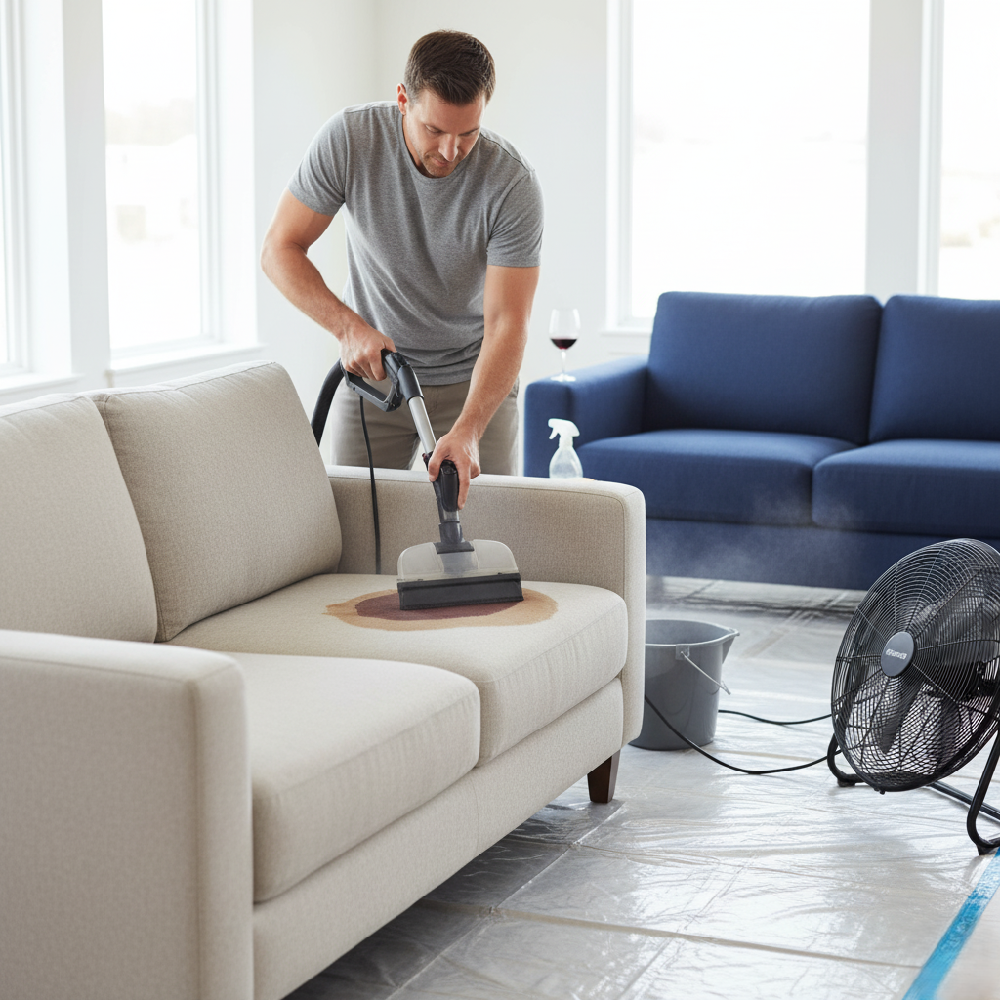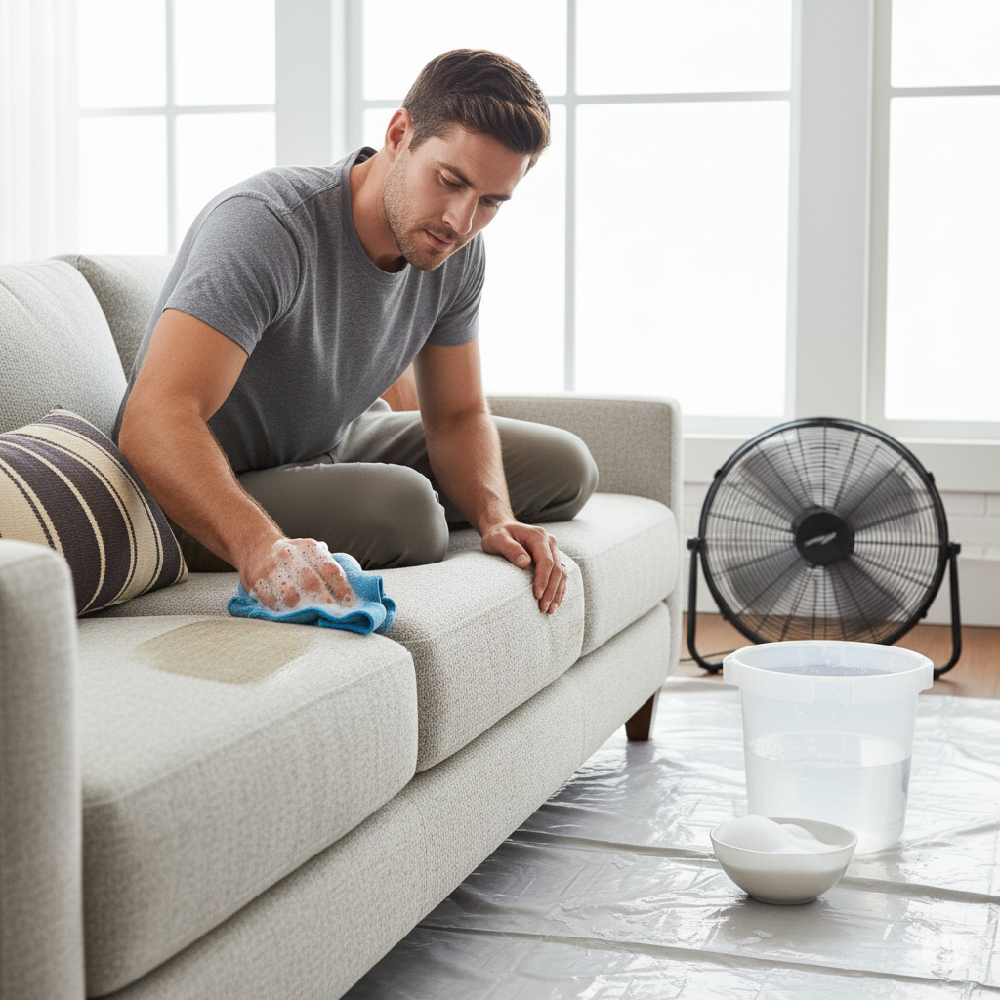Stop Guessing: A Step-by-Step Guide to Cleaning Your Sofa Based on Its Upholstery Code
Your couch is the centerpiece of your living room, yet it’s a magnet for dust, spills, and allergens. While professional cleaning is effective, deep cleaning your sofa at home can be just as thorough, provided you follow the right expert protocol.
This guide provides a structured, trust-based method for deep cleaning and stain removal, ensuring you protect your upholstery while making it look and feel brand new. We go beyond simple vacuuming to give you the complete, fabric-specific cleaning solution.
Part 1: Mandatory Preparation (The 3 Golden Rules)
Before any cleaning solution or water touches your sofa, you must complete these three foundational steps. Skipping them is the single biggest mistake homeowners make.
1. Locate and Decode Your Upholstery Tag (The Safety Check)
The manufacturer's label is your cleaning Bible. It’s usually found attached to the decking under a removable cushion or underneath the sofa frame. Never deviate from the code:
| Code | Meaning (The Rule) | Safe Cleaning Agents |
| W | Water-Based Cleaner ONLY. | Distilled water, mild dish soap solutions, upholstery shampoos, and steam cleaners. |
| S | Solvent Cleaner ONLY (Dry Clean). | Water-free solvents, rubbing alcohol (Isopropyl), commercial dry-cleaning solvents. NO WATER. |
| W/S | Water or Solvent. | You have the most flexibility. Can use steam, water solutions, or solvent cleaners. |
| X | Vacuum/Brush ONLY. | No liquids whatsoever. Only use a vacuum, brush, or dry cleaning cloths. |
2. The Total Debris Removal (Pre-Clean)
A deep clean must start with dry debris removal to prevent grinding dirt into the fibers

-
Vacuum Thoroughly: Use the crevice tool to get into every seam, corner, and under the cushions. Use the upholstery brush attachment for the main surfaces.
-
Deodorize and Lift Grime (Optional Deep-Lift): Lightly sprinkle the entire sofa with baking soda. Let it sit for at least 30 to 60 minutes (or overnight) to absorb odors and lift fine particles. Vacuum every speck of baking soda away.
3. Always Patch Test (The Insurance Policy)
Always test your chosen cleaning solution (whether DIY or commercial) on an inconspicuous area, such as the back corner of the skirt or under the cushion.
-
Wait 10 Minutes: Check for discoloration, shrinkage, or texture change.
-
Color Fastness Check: Blot the test area with a clean white cloth. If any color transfers to the cloth, stop immediately—your fabric is not colorfast with that product.
Part 2: Deep Cleaning Methods by Fabric Code
Once prepared, follow the method specific to your couch's upholstery code for a safe and effective deep clean.
Method A: For 'W' and 'W/S' Codes (The Water Method)
This method uses moisture and is ideal for most cotton, linen, microfiber, and synthetic blends.
Step 1: Create Your Cleaning Solution
Combine 1 teaspoon of mild, clear, liquid dish soap (not laundry detergent) with 2 cups of distilled water in a bucket. Whisk to create a light layer of suds. Distilled water prevents mineral deposits that can cause water spotting.
Step 2: Clean the Surface
Dampen a clean microfiber cloth with the suds (you want only the foam, not soaking water). Wipe the entire surface of the sofa, working in small sections. Focus on scrubbing lightly in a circular motion.

Step 3: The Critical Rinse
This is the step most DIY cleaners skip. Fill a second bucket with plain distilled water. Dampen a separate, clean cloth with the rinse water and go over every section you cleaned. This removes soap residue which otherwise acts as a magnet for new dirt.
Step 4: Speed Drying
Press the sofa firmly with a dry towel to absorb maximum moisture. Run a floor fan directly on the couch immediately afterward to promote air circulation and prevent mold or musty odors.
Method B: For 'S' Codes (The Solvent/Dry Method)
This method requires non-water solvents and is common for delicate fabrics like silk, rayon, or certain velvets.
Step 1: Use Rubbing Alcohol
Rubbing alcohol (Isopropyl alcohol) is an accessible and effective dry solvent. Pour a small amount into a spray bottle.
Step 2: Apply and Blot
Lightly mist a small section of the sofa with the alcohol. Immediately blot the area vigorously with a clean, dry white cloth. The alcohol should evaporate almost instantly, lifting the dirt.
Step 3: Repeat Section by Section
Continue this light mist-and-blot process, using a fresh section of your cloth for each new area, until the entire sofa has been treated.
🚨 Caution: Rubbing alcohol is flammable. Ensure your area is well-ventilated and free from open flames or sparks.
Our new guide reveals 3 easy methods to make any couch taller, even those without legs! Say goodbye to low-rider seating.
Part 3: Expert Stain Removal Cheatsheet
Always address stains immediately. For the best results, use a blotting motion (press and lift) rather than scrubbing, which can damage fibers and spread the stain.
| Stain Type | Recommended First-Line Treatment | Application Protocol |
| Grease / Oil (e.g., butter, makeup) | Baking Soda / Cornstarch (Dry Powder) | Immediately cover the stain entirely with a thick layer of powder. Let sit for at least 15 minutes to absorb the oil. Vacuum the powder away before applying any liquid. |
| Coffee / Wine / Juice | Dish Soap Solution (W/W/S Code Only) | Blot the excess liquid first. Apply a small amount of the detergent solution (from Part 2, Method A) with a cotton swab. Blot with a damp, cool cloth, then a dry towel. |
| Protein (e.g., blood, vomit) | Cold Water ONLY | Use a cloth dampened with cold water. Hot water will immediately "cook" the protein, setting the stain permanently. Blot gently until the stain is lifted. |
| Mystery Stains (W/S Code) | White Vinegar Solution | Combine equal parts water and white vinegar. Lightly blot the stain, working from the outside in. Follow with a clean water rinse and immediate drying. |
Part 4: Advanced Techniques for an Ultra-Deep Clean
1. Disinfecting and Sanitizing (Pets/Used Couches)
A standard clean removes dirt, but disinfecting is crucial for bacteria, viruses, and dust mites.
-
Steam Cleaning (W/W/S Codes): A handheld steamer is one of the best disinfectants, as the high heat kills most germs and dust mites. Hold the steamer close, but move quickly to avoid over-wetting.
-
Vodka/Alcohol Spray (S Code Alternative): Lightly mist the sofa with straight plain vodka (or 70% rubbing alcohol). The alcohol will sanitize and evaporate quickly, making it safe for S-code fabrics.
2. Cleaning Foam Cushions (The Bathtub Soak)
If your cushion covers are removable but the foam inserts are dirty or smell stale:
-
Fill a bathtub with warm water and a capful of a mild, gentle detergent.
-
Immerse the foam pad and repeatedly press it to expel air and let the soapy water penetrate.
-
Drain the tub, refill with clean water, and repeat the pressing process until the water runs clear and all soap is removed.
-
Dry completely: Stand the foam on its edge in a well-ventilated area for 2-3 days, turning frequently. Do not use heat, as it can damage the foam.
HOW TO CLEAN LEATHER COUCH. Get the expert guide to deep cleaning, conditioning, and 100% odor removal. Your sofa deserves it!
FAQ: Expert Cleaning Questions Answered
Q: Can I use a carpet cleaner/shampooer on my couch?
A: Yes, but with extreme caution and only on W or W/S coded fabrics. Use a dedicated upholstery attachment, use minimal water/solution, and ensure you use the suction function extensively to extract as much moisture as possible to prevent mildew.
Q: What about leather or vinyl sofas?
A: These require different care. Use a vacuum followed by a gentle wipe-down with a specialized leather cleaner or a very mild dish soap and distilled water solution. Avoid all harsh chemicals like vinegar, alcohol, or ammonia, as they dry out the material and cause cracking.
Q: How do I remove pet hair from the crevices?
A: After vacuuming with the crevice tool, a slightly dampened rubber glove or a window squeegee is the most effective tool. The rubber creates static friction that bundles the hair together, allowing you to easily pull it out of seams and corners.
From thrones of power to your cozy living room: Dive into the fascinating evolution of the sofa! 🛋️Discover the hidden history of your favorite couch in our latest blog post!
